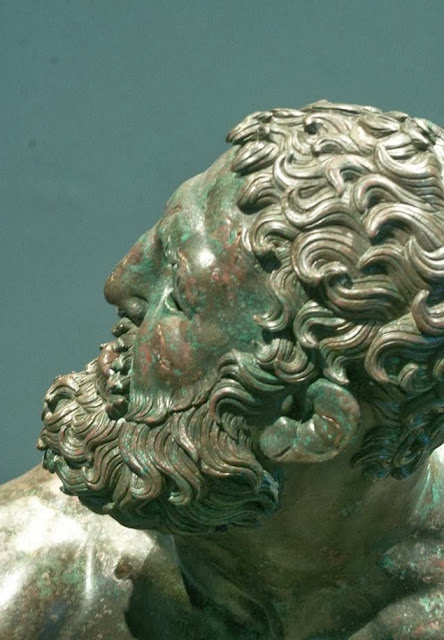The statue is in the Getty
Museum in Malibu. It is made of bronze, and like bronze in general, the
material itself does incredible things with light. The statue is practically
alive, you can feel the exhaustion of the tired athlete and at the same time
the heightened tension. Not only is his face talkative, but his whole body and
posture. Bronze as a material contributes to the vitality of the work with the
shadows of the body.
when it was found
The weight of the body is held
by the right leg, the right arm extends towards the head, and this puts a load
on the entire right half of the wrestler, while the left hip relaxes loosely
along with the unloaded left leg and left arm. He had a palm branch in his left
hand, but unfortunately it is no longer there today. The whole tension is
further increased by the fact that the head also turns to the left.
By contrasting parts of the
body in this way, this “opposite” method of Lysippos realizes Pythagoras
’theory of opposite pairs: right and left, calm and movement, light and shadow.
Pliny’s finding is attested to by Lyssippos ’impressive work in every detail , if
we take a close look at the Boxer’s straps. Not only the straps but also the nails and
fingers are carved with incredible thoroughness. The skin stretches lifelike on
the statue.
The special feature of the
sculpture is the addition of copper: these are the tiny drops of blood on his
arms and thighs dripping from his crushed face. The drops are falling right
now, in front of our eyes, to his muscular arm trembling with exhaustion, on
which the skin ripples gently, the moment the boxer looks at us, the viewers. His
face is tired, exhausted, and we caught his eyes in an intimate moment when we
can see how vulnerable a warrior swollen by force was actually. Although we do
not see his teeth, the curve of his mouth reveals that some teeth are missing. Notice
the line of your upper lip: you can be seen well that the skin is gently
deepened in place of the previously lost teeth! He could get a good big punch
under his left eye. Lysippos solved the swollen and discolored skin surface
here by adding a different kind of bronze.
The rupture of the overworked skin and the scar are clearly visible
under both eyes. Wounds and small cracks also cut into the eyebrows and
forehead. He fought his fight, now tired, very tired and resting. Rest, on the
other hand, is not yet the end of the fight, as he is waiting with intense
attention. That’s why he looks out of the scene, that’s why he turns out of the
harmonious balance of his own world, and that’s why he disturbs the balance of
the whole composition with this turning to the right: waiting for something. Maybe
he’s waiting for the results to be announced, maybe he’s just looking at us,
the observers. In any case, it’s very exciting to engage in a moment of
eloquent solitude in a boxer.
His ears are also interesting,
which the master also took great care of. The ear is like a “typical” ear of a
wrestler: it has been completely deformed from numerous previous injuries, and
presumably it has also damaged his hearing. The arch of his nose also reveals
his previous injuries, it may have broken more than once.
A thousand things are reflected
in the heat of the moment on his face. He blows, gasping for exhaustion, the
hairs of his mustache sweating apart. And another curiosity about his face: the
eye. I mean, the lack of it. Sometimes the eyes for the sculptures were made of
precious stones and alloys, which were placed separately in the eye socket. These
were fondly scratched by the trolls of later ages, leaving us with relatively
few statues that look down on us with their original, jeweled eyes. But they
are certainly breathtaking. Maybe they’re lifelike, maybe they’re exciting in
their own bizarre way.
It’s just a single moment, but
Lysippos gave the flesh-and-blood hero, the bronze-bodied warrior, to
eternity, who is at once fallen,
vulnerable, tired, and thus human, very human.












Comments
Post a Comment